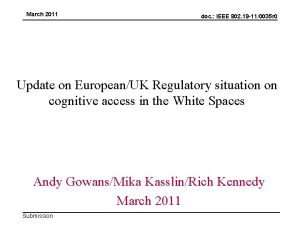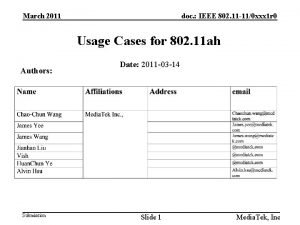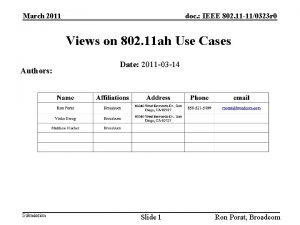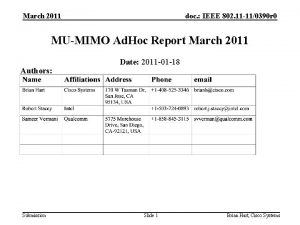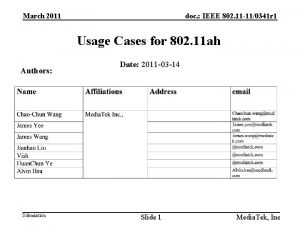March 2011 doc IEEE 802 11 110357 r








- Slides: 8

March 2011 doc. : IEEE 802. 11 -11/0357 r 0 A focused path torwards TGai D 1. 0 Date: 2011 -03 -14 Authors: Submission Slide 1 Marc Emmelmann, Fraunhofer FOKUS

March 2011 doc. : IEEE 802. 11 -11/0357 r 0 Abstract Focused path towards D 1. 0 of TGai summarizing scope and assumptions of TGai per PAR & 5 C. Submission Slide 2 Marc Emmelmann, Fraunhofer FOKUS

March 2011 doc. : IEEE 802. 11 -11/0357 r 0 TGai Problem Statement & Scope FIA SG Agreed problem statement: To much time spent in 802. 11 link set-up Four major aspects: (1) AP discovery, (2) Network Discovery, (3) secure 802. 11 link set-up, (4) higher layer (IP addr. Assignment) (1), (3), and (4) main focus of upcoming TG; (2) addressed by TGu Biggest potential for performance improvement: AP discovery & “parallelization of message exchanges” for higher layer protocols Security: pre-conditions for security scheme strongly influence potential performance gain TGai FLS Scope: Modifications to the 802. 11 MAC to enable fast link set-up “link” as defined per IEEE 802. 11 baseline Application layer end-to-end- (secure) link set not in scope of TGai Concurrency in the exchange of higher layer messages during 802. 11 link set-up is one approach to reduce the total time spent in link set-up (even if considering appl. Layer end 2 end links) but: providing schemes for providing concurrent message exchange is enough, TGai does not need to consider a completed link establishment on higher layers (just enable an “early” start of message exchange) Submission Slide 3 Marc Emmelmann, Fraunhofer FOKUS

March 2011 doc. : IEEE 802. 11 -11/0357 r 0 Definition of Link & Evaluation of Link Set -Up time • We had several discussions during SG phase on the definition of “link”. Based on this discussion, the PAR uses language within the context of IEEE 802. 11, i. e. : 3. 76 link: In the context of an IEEE 802. 11 medium access control (MAC) entity, a physical path consisting of exactly one traversal of the wireless medium (WM) that is used to transfer an MAC service data unit (MSDU) between two stations (STAs). [IEEE 802. 11 -2007] • Given that TGai’s goal is to explore how to use concurrency of higher layer message exchanges during 802. 11 link set-up, TGai should agree on an evaluation criteria for comparing proposals which also considers higher layer aspects – This does not change the scope of TGai – Based on the discussion during SG phase, TGai should consider for evaluation purposes STA can access “the Internet” Submission • The time when a local (!!!) IP address is assigned to a STA as the end of the link set up • Open: when to start measuring? When STA enters AP coverage (assuming perfect knowledge for evaluation purposes)? Slide 4 Marc Emmelmann, Fraunhofer FOKUS

March 2011 doc. : IEEE 802. 11 -11/0357 r 0 Increase in Link Set-Up Time No Assumptions (Today) Link Set. Up Phase Increase in A-Priori Knowledge A-priori Knowledge vs. Performance Submission E. g. RSNA as in IEEE 802. 11 No assumptions on architecture (DHCP Server anywhere in the AP’s subnet) RSNA in combination with improved message exchange Perfect Knowledge (E. g. location based information on APs’ frequency and coverage) AP / Network Discovery Strong assumptions (e. g. DHCP Server colocated with AP) E. g. pre-shared keys (i. e. SIM card) Vender specific cross-layer implementations Assumptions will influence the acceptance of the 802. 11 WG of proposals / the TGai draft. Assumptions have to be stated per proposal for assessment purposes. Shall TGai limit assumptions ? Secure 802. 11 Link Set-Up Higher Layer Protocol Exchange (IP Addr. Assignment) Concurrency of higher layer protocol message exchange Slide 5 Marc Emmelmann, Fraunhofer FOKUS

March 2011 doc. : IEEE 802. 11 -11/0357 r 0 Way forward: focused towards comprehensive Draft R 1. 0 to get immediate WG feedback Use Cases & Scenarios Ideas for Improvements Assumptions FIA SG Optional: Derived assumptions limiting technical proposals Individual Use Case & Scenario Submissions Submission Keep focused on TGai scope TGai Technical / Functional Requirements TGai Use Case Document Avoid duplication of use cases & scenarios yielding to same requirements. Represent all interest groups Slide 6 Address initial areas for improvements 1 st Individual Submissions on selected improvements areas TGai Draft 1. 0 TGai FLS Marc Emmelmann, Fraunhofer FOKUS

March 2011 doc. : IEEE 802. 11 -11/0357 r 0 Summary • TGai has a narrow, well defined focus that was intensively discussed during SG phase – keep the project targeted – focus on key working areas as discussed in SG phase – get feedback from the WG by having Draft 1. 0 according to our timeline • Please revisit SG documents if you did not participate in FIA SG; feel free to contact TG Chairs for finding “key documents” Submission Slide 7 Marc Emmelmann, Fraunhofer FOKUS

March 2011 doc. : IEEE 802. 11 -11/0357 r 0 References • • • 11 -10/1152 r 01: TGai PAR 11 -10/1106 r 01: PAR & 5 C Transition from FIA to Fast Initial Link Set-Up 11 -10/0965 r 01: Potential performance improvements with fast initial link set-up Submission Slide 8 Marc Emmelmann, Fraunhofer FOKUS











